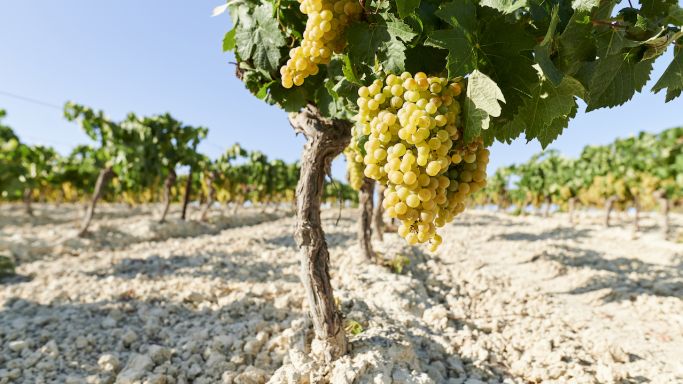A taste of Andalucía's past and future – and it's strikingly beautiful. Starting at €31, $34.99, £36.50.
Alberto Orte’s approach to winegrowing starts with the past. His mission is to rescue extinct varieties, revive forgotten varieties and farm vineyards using old and often abandoned techniques. It all started when he finished his law degree at the University of Madrid but decided that what he really cared about were the wines and vineyards of his mother country. So, he set up a US-based import and distribution company, Olé & Obrigado, with friend Patrick Mata, went back to university to get a Master’s degree in viticulture, and then began to make wine. Right from the start, he wanted to make wine from indigenous varieties and old vines.
In the process, Orte realised that, over the past 120 years, Jerez in particular had more or less lost most of its indigenous varieties. A monoculture had developed around the two main varieties for sherry production, and even the clonal diversity for those two varieties had shrunk. He bought some vineyards and began grafting and planting 26 historical, local white and red varieties, many of them nearly extinct in the region.
He also began to research and look for Palomino clones. Over the years he’s identified and hand-grafted more than 200 old clones. He says that their San Cristóbal vineyard ‘has become the most diverse mother field of native varieties in the Marco de Jerez’. He also works with vineyards and growers in Valdeorras, Yecla and Rioja, and has pretty much dedicated the last 25 years of his life to finding, protecting and bringing back to liquid life, old vineyards and old varieties.
But the wine I really want you to taste has its roots firmly and deeply in the snow-white albariza soils of Cádiz. The variety is called Vijiriega (also known as Bujariego, Diego, Verijadiego Blanco, Vujariego and more than a few spelling variations on all of the above!). In the 1800s it was widespread throughout Andalucía, but over time, with the exception of the Canary Islands, it began to disappear – Wine Grapes suggests that it may be because of low alcohol levels in the wines. It was lost to Cadíz for more than a century. Orte decided to bring it home. He planted a single parcel of Vijiriega in 2013 on one of the most coastal vineyards in Jerez – the vines’ toes are almost in the sea and elevation is just 20 m (66 ft).
Orte farms all his vineyards regeneratively and organically, also using biodynamic practices such as Preparation 500 and cow horns, and this one is no exception. Unusually for the region, it’s planted with native grasses, wildflowers and legumes. The vines are trained and pruned using the traditional Jerez vara y pulgar method, but Orte has taken one step further back (and forward) and uses only ties made of esparto, a native perennial grass, instead of plastic or wire.
The wine is allowed to ferment spontaneously and is foot-trodden in stainless steel before being transferred to barrels of various sizes and ages to finish fermentation and mature on lees (without stirring). After 12 months it’s racked to stainless steel and left for five months to give the wine a chance to naturally stabilise so there is no need to fine or filter.
It’s a wine of striking structure, beauty and complexity. The kind of wine that stops glasses betwixt lips and table, as everyone does a little double pause and looks up at each other in silence. It has the saltiness of Albariño, the crystalline lime purity of great Riesling, the millefeuille layered tension and richness of old-vine Chenin, the honey of Hárslevelű, the focus of Furmint, the almond flowers of Altesse. I am quite sure that it would hold its own in the company of very fine grand cru Chardonnay. In asteroseismology, the study of stars which analyses their internal structure by measuring frequency, amplitude and mode of ‘their intrinsic global oscillations’, scientists have found what they now call ‘the music of the stars’. For those who ‘feel’ or ‘hear’ wines, this is one of those wines that seems to resonate within its own structure. The purity of that, the component of this wine that to me feels like sound, sent goosebumps through my whole body. I wondered for a moment if this might be what it feels like to hear the music of the stars in real time.
No matter if wine doesn’t do that for you. Suffice to say that it’s intense, concentrated, stunningly beautiful right now, and will no doubt be even more beautiful and interesting as it evolves over the next 10 years. £36 may seem expensive for a wine of the week, but it is, in my opinion, very, very good value. And, of course, you’re tasting the past and the future. That in itself is pretty thrilling.
Imported into the UK by Swig and currently available from Swig and Farr Vintners. Imported into the US by Chambers & Chambers Wine Merchants and Olé & Obrigado. Also available in Germany, France, Hong Kong and Jordan (the 2022 is available in Spain).
Every Friday we provide you with a free recommendation for a particularly delicious, ready-to-drink wine that’s available on both sides of the pond and at a very good price. Members can find more reviews for wines from Alberto Orte in our tasting notes database.
Image at top by F J Jimenez via Getty Images; other images from Olé & Obrigado.





